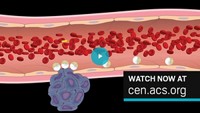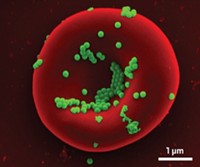Advertisement
Grab your lab coat. Let's get started
Welcome!
Welcome!
Create an account below to get 6 C&EN articles per month, receive newsletters and more - all free.
It seems this is your first time logging in online. Please enter the following information to continue.
As an ACS member you automatically get access to this site. All we need is few more details to create your reading experience.
Not you? Sign in with a different account.
Not you? Sign in with a different account.
ERROR 1
ERROR 1
ERROR 2
ERROR 2
ERROR 2
ERROR 2
ERROR 2
Password and Confirm password must match.
If you have an ACS member number, please enter it here so we can link this account to your membership. (optional)
ERROR 2
ACS values your privacy. By submitting your information, you are gaining access to C&EN and subscribing to our weekly newsletter. We use the information you provide to make your reading experience better, and we will never sell your data to third party members.
Biological Chemistry
New Technique Could Help Personalize Nanomedicine
Drug Delivery: Tracer nanoparticles may predict which tumors will respond to nanomedicine
by Judith Lavelle
November 19, 2015
| A version of this story appeared in
Volume 93, Issue 46

Delivering cancer drugs with nanoparticles should reduce side effects by bringing the packaged drugs directly to tumors instead of distributing them freely throughout a patient’s body. But while this therapy works remarkably well to shrink tumors in some patients, nanomedicines can produce little to no effect in others. A therapy’s success may depend on a given tumor’s ability to uptake and retain these nanoparticles.

Now, researchers from Brigham & Women’s Hospital and Massachusetts General Hospital, led by Omid C. Farokhzad and Ralph Weissleder, report a technique to determine whether a particular patient has a high-uptake or low-uptake tumor (Sci. Transl. Med. 2015, DOI: 10.1126/scitranslmed.aac6522).
Nanoparticles accumulate selectively in tumors thanks to differences between blood vessels in healthy and cancerous tissue. Normal blood vessels, Farokhzad explains, “have very tight junctions with their neighboring cells to make the blood vessels like the piping in your home: They don’t leak.” In a cancerous growth, he continues, “tumor blood vessels are growing so fast that they don’t make those tight junctions,” allowing nanoparticles to leak into the tumor.
But just as some leaky pipes can flood your basement and others leave only a small puddle underneath your sink, blood vessels vary among tumors. Not every tumor has vessels leaky enough to deliver a nanoparticle payload large enough to muster an effective attack on the cancer cells. So Farokhzad, Weissleder, and colleagues sought a way to quantify the leakiness of blood vessels in a tumor and predict how well therapeutic nanoparticles could work for a particular patient.
The team injected rodents bearing human tumors with an FDA-approved anemia treatment called Feraheme, which consists of magnetic iron oxide nanoparticles coated with carboxymethyl dextran. They tagged the particles with fluorescent dyes so they could use high-resolution microscopic imaging to track the distribution of the drug and determine how much of it accumulated in tumor tissue.
They then repeated this experiment to track the accumulation of polymeric nanoparticles, which served as models for cancer nanomedicines. When the team compared each set of images pixel by pixel, they determined that the magnetic particles could predict the distribution of the model anticancer ones with more than 95% accuracy. Therefore, the team concluded that if the magnetic particles accumulate in a tumor, it is very likely that anticancer ones will as well.
The researchers suggest that oncologists could use magnetic resonance imaging in the clinic to trace Feraheme iron oxide particles in a patient. This would allow doctors to decide if that person will benefit more from nanomedicine or standard formulations of a drug.
Feraheme is an FDA-approved drug with few side effects, so “it is conceivable that the approach could be rapidly translated,” says Nicolas Bertrand, a nanoparticle researcher at MIT, who was not involved in the study.
The study, Bertrand continues, is “among the first to introduce the concepts of personalized nanomedicine.”
Oncologists already use principles of personalized medicine—such as prescribing a particular drug on the basis of a specific genetic mutation in a patient’s tumor—to determine the best treatments for their patients. “Everyone in the cancer field should be thinking that nanotherapeutics are no exception,” Farokhzad says.
This article has been translated into Spanish by Divulgame.org and can be found here.




Join the conversation
Contact the reporter
Submit a Letter to the Editor for publication
Engage with us on Twitter